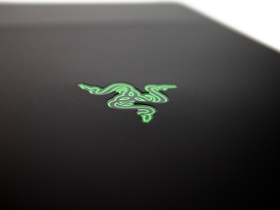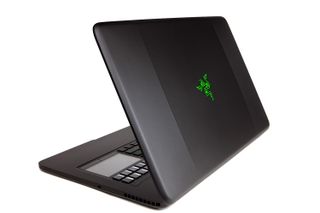Razer's Second-Generation Blade Notebook Review: Focusing On The Z
Razer recently sent us its second-gen Blade, complete with a Core i7-3632QM quad-core CPU and GeForce GTX 660M. Eight gigabytes of memory, a 500 GB hard drive, and an SSD cache round out this 17" gaming notebook. Would you believe it's less than 1" thick?

Meet Razer's Second-Gen Blade
Notebook designers talk about the “Z” (axis) when they refer to the designed thickness of a machine or components inside. The lower the Z, the tougher it is to add complexity and dispel heat. Hence, most gaming notebooks are on the thicker side, since they need the room for large heat sinks and fans. A thermal solution capable of removing the 150+ watts of heat that a high-end gaming system produces simply couldn’t fit inside a MacBook Air. High heat can lead to several unwanted effects. It can shorten the life of batteries and traditional hard drives. Heat can also make a machine uncomfortable to use. In a notebook with a Z as low as Razer's Blade, getting components to fit in, while also getting heat out, becomes the major challenge.
Razer’s motto is “For Gamers. By Gamers”, and it started catering to that demographic in the 90s. Initially, Razer focused on high-end gaming mice to help enthusiasts get the most performance possible by staying on the cutting edge of technology, functionality, and ergonomics. Over the past decade, though, we've seen the company expand its portfolio to include keyboards, headsets, console controllers, and even gaming laptops.

When Razer expanded its line-up with the original Blade, it was a major departure from most gaming notebooks that came before. Razer designed the Blade to generate as much performance as possible in a portable machine, yet it still incorporated a large 17” screen. The company eschewed the bulk and heft of laptop frames commonly used in other 17” gaming machines in favor of a thinner, sculpted body that reduced overall weight. Instead of a large OEM power adapter, Razer created its own, which was lighter and smaller. Instead of a typical trackpad, it included a small touchscreen running the Switchblade UI and ten customizable keys.
The original Razer Blade (released at the tail end of 2011) dealt with thermal challenges by employing a dual-core processor and Nvidia's GeForce GT 555M, a combination that didn't require as much cooling as competing 17" gaming machine. Unfortunately, the match-up also caused the first-gen Blade to lag behind other notebooks in measures of absolute performance. The machine was capable of mid-range gaming, sure. But it was also slower than other systems selling at lower prices. Razer's Blade had the looks and the portability, but it lacked muscle. In the quest for a low Z, the performance trade-off was a little too severe.
The second-generation Blade, which we are reviewing today, represents a major effort to upgrade the machine's performance, while retaining the thinness and features that set the original apart. With a unique quad-core CPU that only dissipates up to 35 watts and a highly-overclocked GeForce GTX 660M, the new Blade should move up a couple of tiers in terms of speed. The cooling system is completely revamped to be more effective than the original, too. To save space, Wi-Fi and Bluetooth are covered by one card. In the end, the second-gen Blade should be what Razer's customers were hoping for all along: the right mix of looks, performance, and portability. Is this the one?
| Razer Blade (Second Generation) System Specs | |
|---|---|
| Processor | Intel Core i7-3632QM Quad Core: 4C/8T, 2.2 GHz Base Clock Rate, 3.2 GHz Maximum Turbo Boost, 6 MB Shared L3 Cache, 35 W TDP |
| Platform | Intel HM77 Express Chipset |
| Memory | 8 GB Dual-Channel DDR3 at 1600 MT/s |
| Graphics | Nvidia GeForce GTX 660M 2 GB GDDR5 with Nvidia Optimus Technology |
| Solid State Drive | Lite-On LMT-64M3M64GB SATA 6Gb/s SSD with Nvelo Dataplex Software (Cache Acceleration) |
| Hard Drive | Hitachi HTS725050A7E630 500 GB 7,200 RPM Hard Drive (Primary Storage) |
| Display | AU Optronics B173HW01 V5 17.3" FHD 16:9 Glossy LED Backlight LCD, 1920x1080 |
| Wi-Fi | Intel Centrino Advanced-N 6235 AGN 2x2 HMC Wi-Fi/Bluetooth Adapter (802.11a/g/n) + BT V4.0 |
| Ethernet | Realtek RTL8168 PCIe 10/100/1,000 Mb/s Ethernet |
| Audio | Stereo 2.0 with Dolby Home Theater v4 and HDMI 1.4 Support |
| Operating System | Microsoft Windows 7 Home Premium (64-bit) |
| Webcam | Integrated Webcam / Microphone |
| Security | Kensington Security Slot |
| Ports | USB 3.0 (x3), Headphone/Mic Combo, HDMI v1.4 |
| Battery | Integrated 60 Wh (64.5 Wh Capacity as shown in test unit) |
| AC Adapter | 120 W |
| Weight | 6.6 lbs |
| Dimensions | 16.81" (Width) x 10.9" (Depth) x 0.88" (Height) |
| Warranty | One Year Tech Support, Labor, and Parts.Extended 2 year warranty (excludes battery) for an additional $299.99. |
| Price | $2,499 |
Stay On the Cutting Edge: Get the Tom's Hardware Newsletter
Get Tom's Hardware's best news and in-depth reviews, straight to your inbox.
-
ShadyHamster Having all the I/O on the left isn't such a bad idea, keeps the right side clear so cables don't get in the way if you use a mouse close to your laptop like i do.Reply -
mayankleoboy1 Wow, this is a very thorough review! Great work!Reply
This notebook has looked into almost every possible detail. I was particularly impressed that in the heat run, the "WASD" key area was cooler than the rest. This bespeaks extreme attention to details. -
Chairman Ray This is an amazing system. Great job by Razer! I won't be buying it due to the steep price tag, but definitely going to recommend it to those who are willing to pay for the best.Reply -
xpeh While the price is steep, this laptop is definitely one of the best looking gaming laptops I've ever seen.Reply -
g-unit1111 I very badly need to get a new laptop but this one is way too rich for my blood. I would definitely consider this if it were about $1K less.Reply -
Pyree g-unit1111I very badly need to get a new laptop but this one is way too rich for my blood. I would definitely consider this if it were about $1K less.Lenovo Y580/Y500 GT650m SLIReply -
slomo4sho xpehWhile the price is steep, this laptop is definitely one of the best looking gaming laptops I've ever seen.IMO having a $1000 gaming desktop and spending $500-600 on a laptop when Haswell comes out is probably much more economical for the occasional gaming on a laptop paired with a sold desktop to enjoy the higher quality graphics. Even at $2500, this laptop can't even keep up with the $500 budget gaming build from last month.Reply -
de5_Roy nice review. :)Reply
my real amusement came from the apu-powered laptop's performance, though. it bottlenecked the discreet gpu so badly.... :D -
corvak Gaming laptops have never been priced in a range that makes them worth buying for me. They don't really have enough battery life to really take advantage of portability, and the price/performance is in a whole other league if you compare it to any desktop build.Reply
Even buying a cheap laptop for travel use alongside a gaming desktop is likely to come in cheaper than many of these.
-
Goose_Nipples ARMY'S KA-Bar?!?!?!?! Hooooooold up my friend. Devil dog here who's jimmies have most assuredly been rustled.Reply
Most Popular

